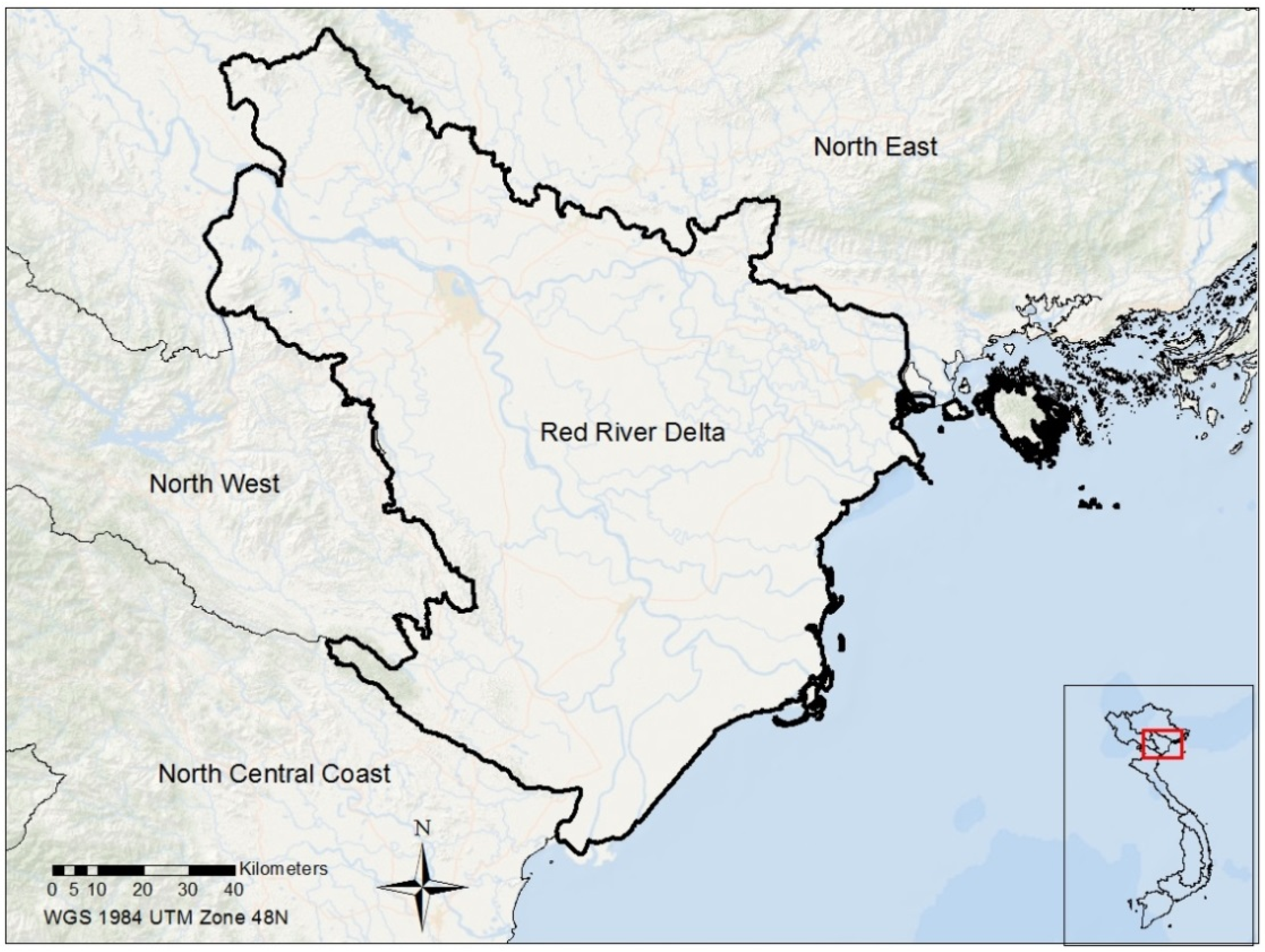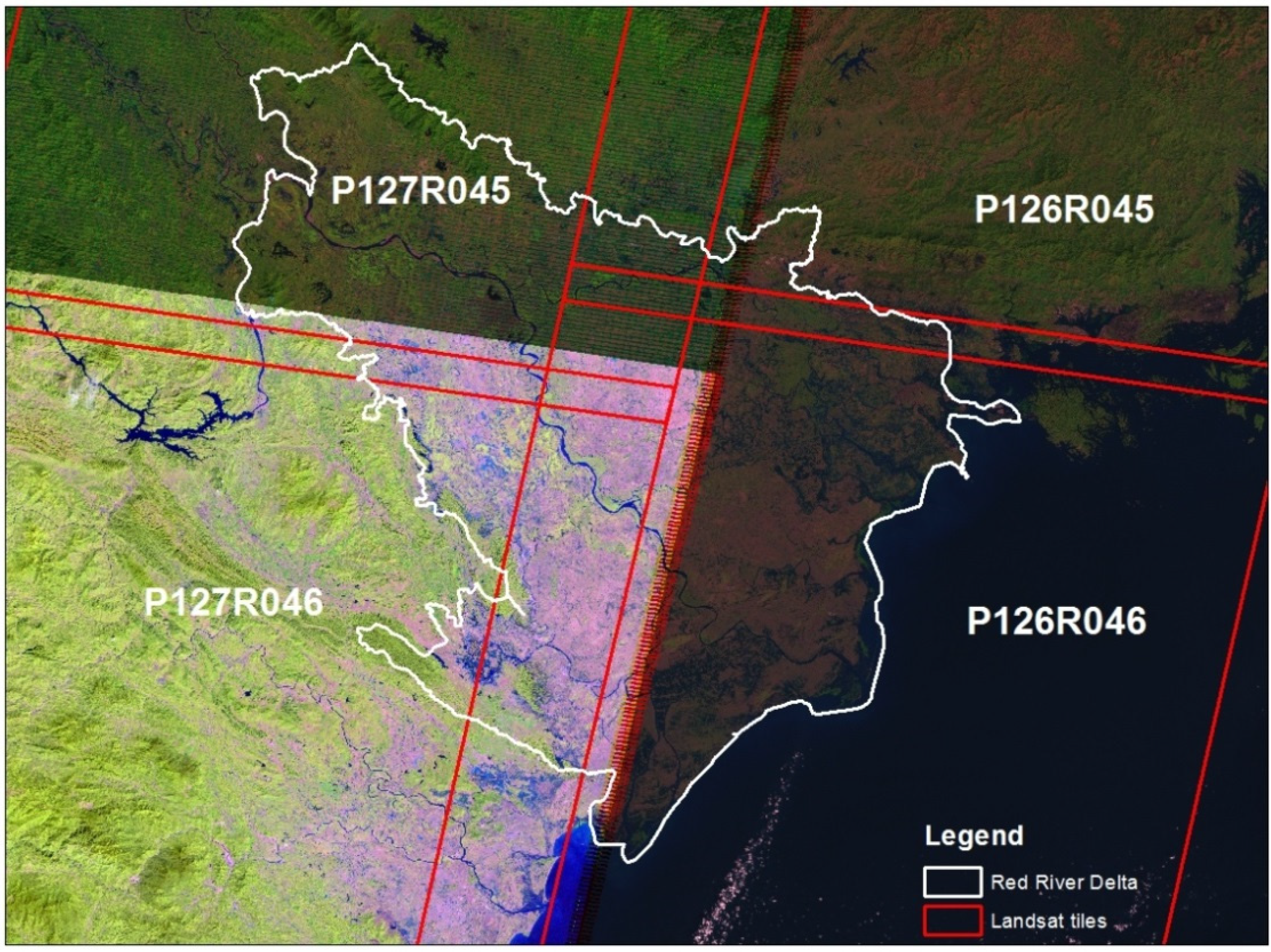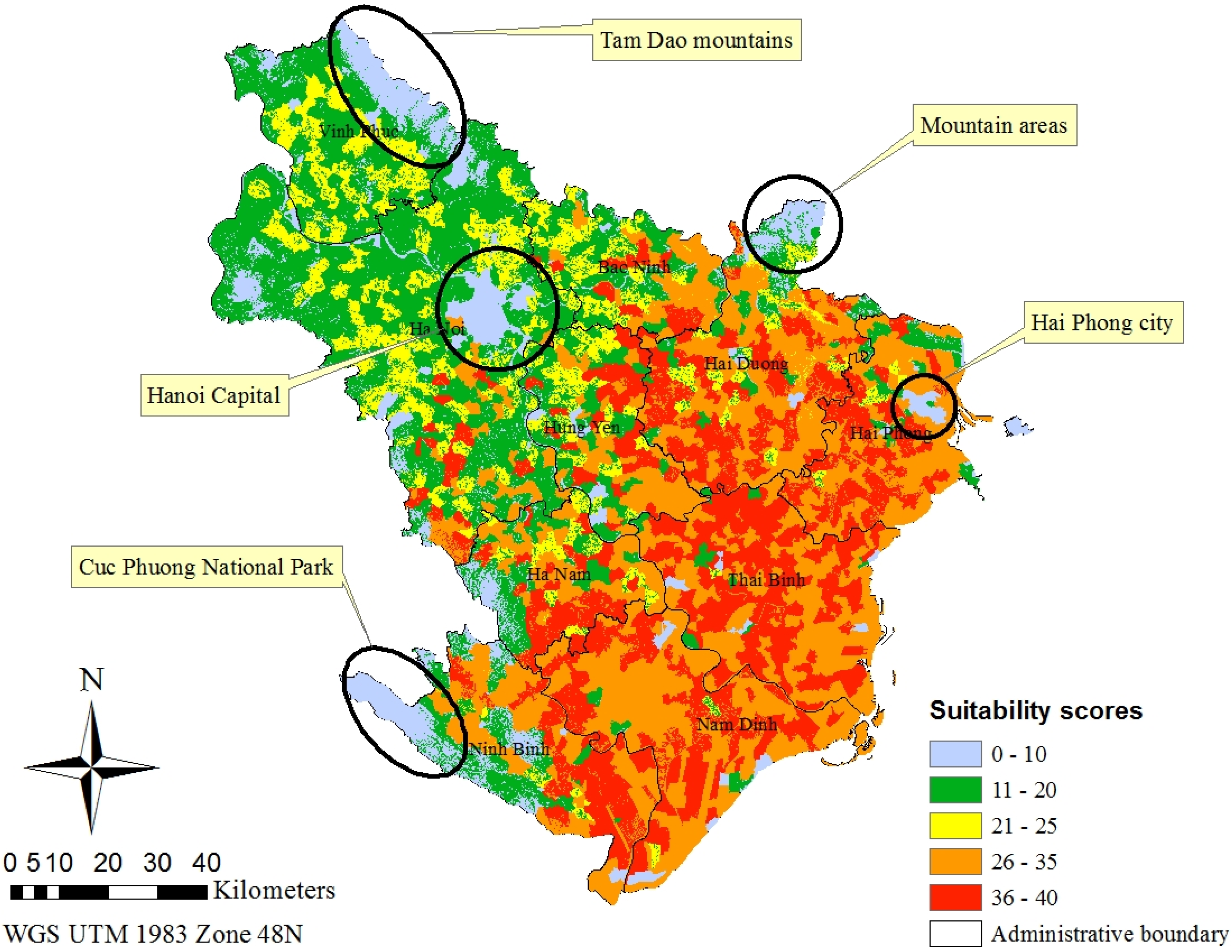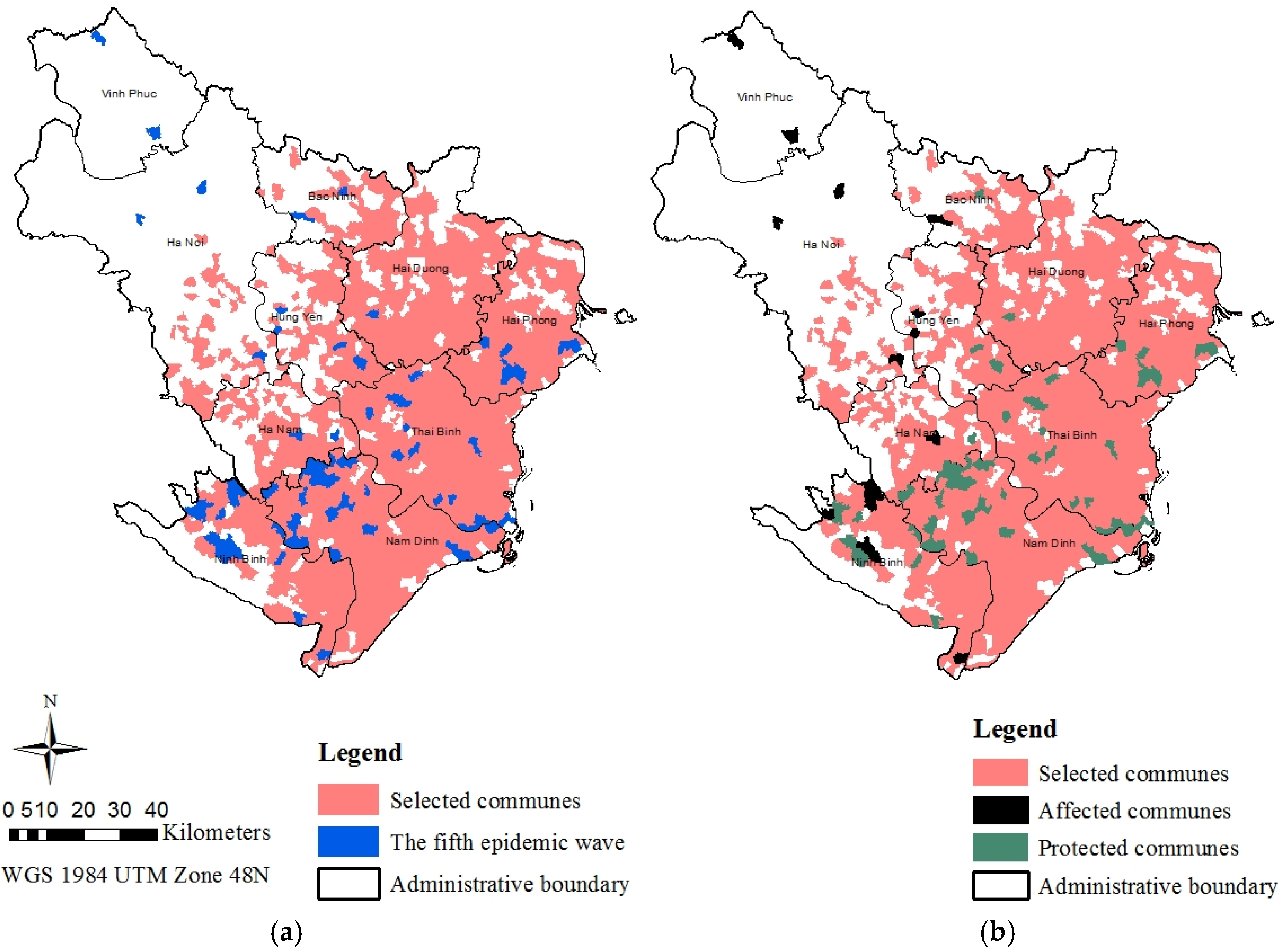An Alternative Vaccination Approach for The Prevention of Highly Pathogenic Avian Influenza Subtype H5N1 in The Red River Delta, Vietnam —A Geospatial-Based Cost-Effectiveness Analysis
Abstract
:1. Introduction
2. Methods
2.1. Study Area and Data Sources


2.2. Statistical Analysis
2.2.1. Ex Ante Analysis
| Factors | Data Sources | Attribute Values of Factors |
|---|---|---|
| Water bird density (heads/km2) | The 2006 Vietnam Rural, Agricultural and Fishery Census | 0–892 |
| 893–2097 | ||
| 2098–4299 | ||
| >4299 | ||
| Chicken density (heads/km2) | The 2006 Vietnam Rural, Agricultural and Fishery Census | 0–1738 |
| 1739–3992 | ||
| 3993–9472 | ||
| >9472 | ||
| Elevation (m) | SRTM 90-m resolution DEM: http://srtm.csi.cgiar.org/ [20] | ≤5 |
| >5–15 | ||
| >15–200 | ||
| >200 | ||
| Land use/land cover (%) | The 2006 Vietnam Rural, Agricultural and Fishery Census | Agriculture |
| Aquaculture | ||
| Built-up | ||
| Forest/perennial trees |
2.2.2. The Cost-Effectiveness Analysis
3. Results and Discussion
3.1. Results
3.1.1. Ex Ante Analysis
| Variable | Weight (%) |
|---|---|
| Water bird density | 19 |
| Land used for rice paddy field | 18 |
| Elevation | 18 |
| Land used for aquaculture | 17 |
| Land used for built-up purposes | 14 |
| Chicken density | 12 |
| Land used for forest/perennial trees | 2 |
| Factors | Attribute Values of Factors | Attribute Weight (%) |
|---|---|---|
| Water bird density (heads/km2) | 0–892 | 11 |
| 893–2097 | 76 | |
| 2098–4299 | 7 | |
| >4299 | 6 | |
| Chicken density (heads/km2) | 0–1738 | 37 |
| 1739–3992 | 27 | |
| 3993–9472 | 25 | |
| >9472 | 11 | |
| Elevation (m) | ≤5 | 73 |
| >5–15 | 16 | |
| >15–200 | 11 | |
| >200 | 0 | |
| Land use/land cover (%) | Agriculture | 46 |
| Built-up | 35 | |
| Aquaculture | 17 | |
| Forest/perennial trees | 2 |

3.1.2. Cost-Effectiveness Analysis of Vaccination Programs and Policy Implications

| Content | Before Vaccination Program | National Poultry Vaccination Program | Alternative Vaccination Program |
|---|---|---|---|
| Total number of communes involved in vaccination program | 0 | 2248 | 1137 |
| Number of rounds of vaccination per year | 0 | 2 | 5 |
| Number of birds vaccinated per round (Thousand heads) | 0 | 59,241 | 31,171 |
| Number of affected communes | 193 | 74 | 13 |
| Infection rate (%) | 8.59 | 3.29 | 0.58 |
| Effectiveness (%) | 61.66 | 93.26 | |
| Vaccination cost (Million U.S. $) | 0 | 4.50 | 5.92 |
| Number of birds culled (Thousand heads) | 6375 | 2165 | 395 |
| Cost of culling birds (Million U.S. $) | 1.59 | 0.54 | 0.10 |
| Government compensation (Million U.S. $) | 7.95 | 2.68 | 0.49 |
| Number of communes included in emergency vaccination | 543 | 304 | 92 |
| Number of birds vaccinated in emergency vaccination (Thousand heads) | 0 | 8625 | 2898 |
| Cost of emergency vaccination (Million U.S. $) | 0 | 0.33 | 0.11 |
| Farmers loss (Million U.S. $) | 4.95 | 1.65 | 0.30 |
| Total loss (Million U.S. $) | 14.49 | 9.70 | 6.92 |
3.2. Discussion
4. Conclusions
Acknowledgments
Author Contributions
Conflicts of Interest
References
- OIE. Follow-Up Report No. 8. Available online: http://www.oie.int/wahis_2/temp/reports/en_fup_0000014834_20140225_152400.pdf (accessed on 5 September 2014).
- Phan Dang, T.; Duquesne, B.; Lebailly, P.; Vu Dinh, T. Diversification and epidemic risks of poultry production systems in Hanoi suburban. J. Sci. Dev. 2010, 8, 203–215. [Google Scholar]
- Peyre, M.; Desvaux, S.; Phan Dang, T.; Rossi, V.; Renard, J.F.; Vu Dinh, T.; Roger, F. Financial evaluation of vaccination strategies against HPAI. A modeling approach. In Proceedings of AI Research to Policy International Workshop, FAO, Hanoi, Vietnam, 16–18 June 2008.
- Desvaux, S.; Ton, V.D.; Phan Dang, T.; Hoa, P.T.T. A General Review and Description of the Poultry Production in Vietnam; Agricultural Publishing House: Hanoi, Vietnam, 2008. [Google Scholar]
- Tran, C.C.; Yost, R.S.; Yanagida, J.F.; Saksena, S.; Fox, J.; Sultana, N. Spatio-temporal occurrence modeling of highly Pathogenic Avian Influenza subtype H5N1: A case study in the Red River Delta, Vietnam. ISPRS Int. J. Geo-Inf. 2013, 2, 1106–1121. [Google Scholar] [CrossRef]
- World Bank. The Avian Influenza Emergency Recovery Project: Implementation completion and Results Report; World Bank: Washington, DC, USA, 2007. [Google Scholar]
- CAP. Policy Analysis of HPAI Strategy Including Analysis of Collaboration and Partnership between Public and Private Sectors: Gathering Evidence for A Transitional Strategy (GETS) for HPAI H5N1 Vaccination in Vietnam; Center for Agricultural Policy: Hanoi, Vietnam, 2011. [Google Scholar]
- MARD & MOH. Vietnam: Integrated National Operational Program for Avian and Human Influenza (OPI) 2006–2010; MARD & MOH: Hanoi, Vietnam, 2006.
- Henning, K.A.; Henning, J.; Morton, J.; Long, N.T.; Ha, N.T.; Meers, J. Farm-and flock-level risk factors associated with Highly Pathogenic Avian Influenza outbreaks on small holder duck and chicken farms in the Mekong Delta of Viet Nam. Prev. Vet. Med. 2009, 91, 179–188. [Google Scholar] [CrossRef] [PubMed]
- Minh, P.Q.; Morris, R.S.; Schauer, B.; Stevenson, M.; Benschop, J.; Nam, H.V.; Jackson, R. Spatio-temporal epidemiology of highly Pathogenic Avian Influenza outbreaks in the two deltas of Vietnam during 2003–2007. Prev. Vet. Med. 2009, 89, 16–24. [Google Scholar] [CrossRef] [PubMed]
- Taylor, N.; Dung, D.H. An Analysis of Data Generated by Post-Vaccination Sero-Monitoring and Surveillance Activities, Following HPAI Vaccination in Viet Nam (2005–2006); FAO: Hanoi, Vietnam, 2007; p. 46. [Google Scholar]
- Sims, L.; Do, H.D. Vaccination of Poultry in Vietnam against H5N1 Highly Pathogenic Avian Influenza; Australian Government Department of Agriculture, Fisheries and Forestry: Canberra, Australia, 2009.
- MARD & MOH. Avian and pandemic influenza Vietnam’s experience. In Proceedings of International Ministerial Conference on Animal and Pandemic Influenza, Hanoi, Vietnam, 19–21 April 2010.
- Pfeiffer, D.U.; Minh, P.Q.; Martin, V.; Epprecht, M.; Otte, M.J. An analysis of the spatial and temporal patterns of highly Pathogenic Avian Influenza occurrence in Vietnam using national surveillance data. Vet. J. 2007, 174, 302–309. [Google Scholar] [CrossRef] [PubMed]
- Desvaux, S.; Grosbois, V.; Pham, T.T.H.; Fenwick, S.; Tollis, S.; Pham, N.H.; Tran, A.; Roger, F. Risk factors of highly Pathogenic Avian Influenza H5N1 occurrence at the village and farm levels in the Red River Delta Region in Vietnam. Transbound. Emerg. Dis. 2011, 58, 492–502. [Google Scholar] [CrossRef] [PubMed]
- Gilbert, M.; Chaitaweesup, P.; Parakamawongsa, T.; Premashthira, S.; Tiensin, T.; Kalpravidh, W.; Wagner, H.; Slingenbergh, J. Free-grazing ducks and highly Pathogenic Avian Influenza, Thailand. Emerg. Infect. Dis. 2006, 12, 227–234. [Google Scholar] [CrossRef] [PubMed]
- Gilbert, M.; Xiao, X.; Pfeiffer, D.U.; Epprecht, M.; Boles, S.; Czarnecki, C.; Chaitaweesub, P.; Kalpravidh, W.; Minh, P.Q.; Otte, M.J.; et al. Mapping H5N1 highly Pathogenic Avian Influenza risk in southeast Asia. Proc. Natl. Acad. Sci. USA 2008, 105, 4769–4774. [Google Scholar] [CrossRef] [PubMed]
- FAO Summary of Highly Pathogenic Avian Influenza (HPAI) Situation in Viet Nam 31 December 2008. Available online: http://www.un.org.vn/images/stories/press_centre/2008_hpai_update_31dec08.pdf (accessed on 21 October 2010).
- Saksena, S.; Fox, J.; Epprecht, M.; Tran, C.; Nong, D.; Spencer, J.; Nguyen, L.; Finucane, M.; Tran, V.; Wilcox, B. Evidence for the convergence model: The emergence of highly Pathogenic Avian Influenza (H5N1) in Viet Nam. PLoS ONE 2015, 10, e0138138. [Google Scholar] [CrossRef] [PubMed]
- CGIAR-CSI. Shuttle Radar Topography Mission (SRTM) 90-m Resolution Digital Elevation Model (DEM). Available online: http://srtm.csi.cgiar.org/ (accessed on 2 March 2015).
- USGS. USGS EROS Data Center. Available online: http://glovis.usgs.gov/ (accessed on 28 October 2013).
- ESRI. How Weighted Overlay Works. Available online: http://resources.arcgis.com/en/help/main/10.1/index.html#//009z000000s1000000 (accessed on 10 September 2014).
- Gilbert, M.; Xiao, X.; Domenech, J.; Lubroth, J.; Martin, V.; Slingenbergh, J. Anatidae migration in the western Palearctic and spread of highly Pathogenic Avian Influenza H5N1 virus. Emerg. Infect. Dis. 2006, 12, 1650–1656. [Google Scholar] [CrossRef] [PubMed]
- Shahid, S. Impact of climate change on irrigation water demand of dry season Boro rice in northwest Bangladesh. Clim. Change 2011, 105, 433–453. [Google Scholar] [CrossRef]
- Jayakumar, S.; Arockiasamy, D.I.; Britto, S.J. Conserving forests in the eastern Ghats through remote sensing and GIS-A case study in Kolli hills. Curr. Sci. 2002, 82, 1259–1266. [Google Scholar]
- Münch, Z.; Conrad, J. Remote sensing and GIS based determination of groundwater dependent ecosystems in the Western Cape, South Africa. Hydrogeol. J. 2007, 15, 19–28. [Google Scholar] [CrossRef]
- Diamond, J.T.; Wright, J.R. Design of an integrated spatial information system for multiobjective land-use planning. Environ. Plan. B-Plan. Design 1988, 15, 205–214. [Google Scholar] [CrossRef]
- Elith, J.; Leathwick, J.R.; Hastie, T. A working guide to boosted regression trees. J. Anim. Ecol. 2008, 77, 802–813. [Google Scholar] [CrossRef] [PubMed]
- Elith, J.; Catherine, G.; Anderson, P.R.; Dudík, M.; Ferrier, S.; Guisan, A.; Hijmans, J.R.; Huettmann, F.; Leathwick, R.J.; Lehmann, A.; et al. Novel methods improve prediction of species’ distributions from occurrence data. Ecography 2006, 29, 129–151. [Google Scholar] [CrossRef]
- Martin, V.; Pfeiffer, D.U.; Zhou, X.; Xiao, X.; Prosser, D.J.; Guo, F.; Gilbert, M. Spatial distribution and risk factors of highly Pathogenic Avian Influenza (HPAI) H5N1 in China. PLoS Pathog. 2011, 7, e1001308. [Google Scholar] [CrossRef] [PubMed]
- Gilbert, M.; Newman, S.H.; Takekawa, J.Y.; Loth, L.; Biradar, C.; Prosser, D.J.; Balachandran, S.; Rao, M.V.S.; Mundkur, T.; Yan, B.; et al. Flying over an infected landscape: Distribution of highly Pathogenic Avian Influenza H5N1 risk in south Asia and satellite tracking of wild waterfowl. Ecohealth 2010, 7, 448–458. [Google Scholar] [CrossRef] [PubMed]
- Stevens, K.B.; Pfeiffer, D.U. Spatial modelling of disease using data-and knowledge-driven approaches. Spat. Spatio-Temporal Epidemiol. 2011, 2, 125–133. [Google Scholar] [CrossRef] [PubMed]
- Van Boeckel, T.P.; Thanapongtharm, W.; Robinson, T.; Biradar, C.M.; Xiao, X.; Gilbert, M. Improving risk models for avian influenza: The role of intensive poultry farming and flooded land during the 2004 Thailand epidemic. PLoS ONE 2012, 7, e49528. [Google Scholar] [CrossRef] [PubMed]
- Jenks, G.F. The data model concept in statistical mapping. Int. Yearb. Cartogr. 1967, 7, 186–190. [Google Scholar]
- Castrence, M.; Nong, D.H.; Tran, C.C.; Young, L.; Fox, J. Mapping urban transitions using multi-temporal Landsat and DMSP-OLS night-time lights imagery of the Red River Delta in Vietnam. Land 2014, 3, 148–166. [Google Scholar] [CrossRef]
- Schneider, A. Monitoring land cover change in urban and peri-urban areas using dense time stacks of Landsat satellite data and a data mining approach. Remote Sens. Environ. 2012, 124, 689–704. [Google Scholar] [CrossRef]
- Mountrakis, G.; Im, J.; Ogole, C. Support vector machines in remote sensing: A review. ISPRS J. Photogramm. Remote Sens. 2011, 66, 247–259. [Google Scholar] [CrossRef]
- Weinberg, G.A.; Szilagyi, P.G. Vaccine epidemiology: Efficacy, effectiveness, and the translational research roadmap. J. Infect. Dis. 2010, 201, 1607–1610. [Google Scholar] [CrossRef] [PubMed]
- Pfeiffer, D.U. Assessment of H5N1 HPAI risk and the importance of wild birds. J. Wildl. Dis. 2007, 43, S47–S50. [Google Scholar]
- Smith, G.J.D.; Fan, X.H.; Wang, J.; Li, K.S.; Qin, K.; Zhang, J.X.; Vijaykrishna, D.; Cheung, C.L.; Huang, K.; Rayner, J.M.; et al. Emergence and predominance of an H5N1 influenza variant in China. Proc. Natl. Acad. Sci. USA 2006, 103, 16936–16941. [Google Scholar] [CrossRef] [PubMed]
- Songserm, T.; Jam-on, R.; Sae-Heng, N.; Meemak, N.; Hulse-Post, D.J.; Sturm-Ramirez, K.M.; Webster, R.G. Domestic ducks and H5N1 influenza epidemic, Thailand. Emerg. Infect. Dis. 2006, 12, 575. [Google Scholar] [CrossRef] [PubMed]
- Webster, R.G.; Hulse-Post, D.J.; Sturm-Ramirez, K.M.; Guan, Y.; Peiris, M.; Smith, G.; Chen, H. Changing epidemiology and ecology of highly pathogenic avian H5N1 influenza viruses. Avian Dis. 2007, 51, 269–272. [Google Scholar] [CrossRef] [PubMed]
- OIE. Follow-Up Report No. 45. Available online: http://web.oie.int/wahis/reports/en_fup_0000010005_20101204_123300.pdf (accessed on 15 August 2014).
- Pfeiffer, J.; Suarez, D.L.; Sarmento, L.; To, T.L.; Nguyen, T.; Pantin-Jackwood, M.J. Efficacy of commercial vaccines in protecting chickens and ducks against H5N1 highly Pathogenic Avian Influenza viruses from Vietnam. Avian Dis. 2010, 54, 262–271. [Google Scholar] [CrossRef] [PubMed]
- Tran, C.C. Public Policy Instruments for Risk Management of Highly Pathogenic Avian Influenza Subtype H5N1 in Vietnam; University of Kentucky: Lexington, KY, USA, 2010. [Google Scholar]
- Tran, C.C.; Yanagida, J.F. Computational economic analysis of duck production at the farm household level in the context of highly Pathogenic Avian Influenza subtype H5N1 in the Red River Delta, Vietnam. Asian J. Agric. Ext. Econ. Sociol. 2015, 6, 172–184. [Google Scholar] [CrossRef]
- Hinrichs, J.; Sims, L.; McLeod, A. Some direct costs of control for avian influenza. In Proceedings of the 11th International Society for Veterinary Epidemiology and Economics, Cairns, Australia, August 2006.
- Beato, M.S.; Toffan, A.; de Nardi, R.; Cristalli, A.; Terregino, C.; Cattoli, G.; Capua, I. A conventional, inactivated oil emulsion vaccine suppresses shedding and prevents viral meat colonisation in commercial (Pekin) ducks challenged with HPAI H5N1. Vaccine 2007, 25, 4064–4072. [Google Scholar] [CrossRef] [PubMed]
- Alhaji, N.B.; Odetokun, I.A. Assessment of biosecurity measures against highly Pathogenic Avian Influenza risks in small-scale commercial farms and free-range poultry flocks in the northcentral Nigeria. Transbound. Emerg. Dis. 2011, 58, 157–161. [Google Scholar] [CrossRef] [PubMed]
- FAO. Bio-Security for Highly Pathogenic Avian Influenza: Issues and Options. Available online: ftp://ftp.fao.org/docrep/fao/011/i0359e/i0359e00.pdf (accessed on 26 May 2012).
- FAO. FAO Recommendations on the Prevention, Control and Eradication of Highly Pathogenic Avian Influenza (HPAI) in Asia. Available online: http://web.oie.int/eng/AVIAN_INFLUENZA/FAO recommendations on HPAI.pdf (accessed on 26 May 2012).
- FAO. The Importance of Biosecurity in Reducing HPAI Risk on Farms and in Markets. Available online: http://www.fao.org/docs/eims/upload//236621/ah691e.pdf (accessed on 26 May 2012).
- EAP-AP. Land Cover Assessment and Monitoring. Available online: http://www.rrcap.ait.asia/lc/cd/html/vietnam.html (accessed on 8 January 2015).
- Gilbert, M.; Xiao, X.; Chaitaweesub, P.; Kalpravidh, W.; Premashthira, S.; Boles, S.; Slingenbergh, J. Avian influenza, domestic ducks and rice agriculture in Thailand. Agric. Ecosyst. Environ. 2007, 119, 409–415. [Google Scholar] [CrossRef] [PubMed]
- Edan, M. Review of Free-Range Duck Farming Systems in Northern Vietnam and Assessment of Their Implication in The Spreading of The Highly Pathogenic (H5N1) Strain of Avian Influenza (HPAI); Agronomes et Veterinaires sans Frontieres: Lyon, France, 2006; p. 101. [Google Scholar]
© 2016 by the authors; licensee MDPI, Basel, Switzerland. This article is an open access article distributed under the terms and conditions of the Creative Commons by Attribution (CC-BY) license (http://creativecommons.org/licenses/by/4.0/).
Share and Cite
Tran, C.C.; Yanagida, J.F.; Saksena, S.; Fox, J. An Alternative Vaccination Approach for The Prevention of Highly Pathogenic Avian Influenza Subtype H5N1 in The Red River Delta, Vietnam —A Geospatial-Based Cost-Effectiveness Analysis. Vet. Sci. 2016, 3, 6. https://doi.org/10.3390/vetsci3010006
Tran CC, Yanagida JF, Saksena S, Fox J. An Alternative Vaccination Approach for The Prevention of Highly Pathogenic Avian Influenza Subtype H5N1 in The Red River Delta, Vietnam —A Geospatial-Based Cost-Effectiveness Analysis. Veterinary Sciences. 2016; 3(1):6. https://doi.org/10.3390/vetsci3010006
Chicago/Turabian StyleTran, Chinh C., John F. Yanagida, Sumeet Saksena, and Jefferson Fox. 2016. "An Alternative Vaccination Approach for The Prevention of Highly Pathogenic Avian Influenza Subtype H5N1 in The Red River Delta, Vietnam —A Geospatial-Based Cost-Effectiveness Analysis" Veterinary Sciences 3, no. 1: 6. https://doi.org/10.3390/vetsci3010006





